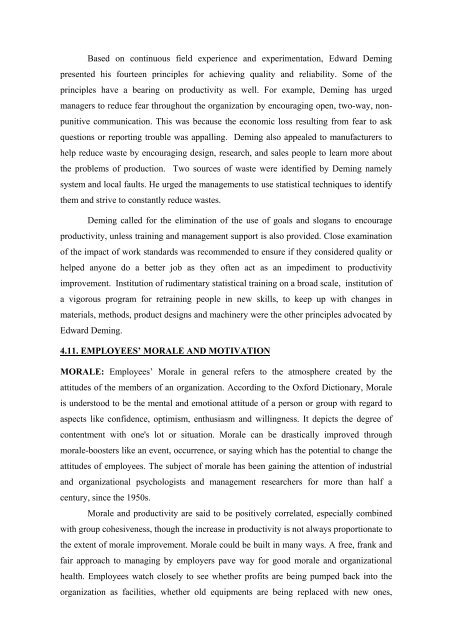UNIT – I Lesson 1 HRM – AN OVERVIEW Lesson Outline Nature of ...
UNIT – I Lesson 1 HRM – AN OVERVIEW Lesson Outline Nature of ...
UNIT – I Lesson 1 HRM – AN OVERVIEW Lesson Outline Nature of ...
Create successful ePaper yourself
Turn your PDF publications into a flip-book with our unique Google optimized e-Paper software.
Based on continuous field experience and experimentation, Edward Deming<br />
presented his fourteen principles for achieving quality and reliability. Some <strong>of</strong> the<br />
principles have a bearing on productivity as well. For example, Deming has urged<br />
managers to reduce fear throughout the organization by encouraging open, two-way, nonpunitive<br />
communication. This was because the economic loss resulting from fear to ask<br />
questions or reporting trouble was appalling. Deming also appealed to manufacturers to<br />
help reduce waste by encouraging design, research, and sales people to learn more about<br />
the problems <strong>of</strong> production. Two sources <strong>of</strong> waste were identified by Deming namely<br />
system and local faults. He urged the managements to use statistical techniques to identify<br />
them and strive to constantly reduce wastes.<br />
Deming called for the elimination <strong>of</strong> the use <strong>of</strong> goals and slogans to encourage<br />
productivity, unless training and management support is also provided. Close examination<br />
<strong>of</strong> the impact <strong>of</strong> work standards was recommended to ensure if they considered quality or<br />
helped anyone do a better job as they <strong>of</strong>ten act as an impediment to productivity<br />
improvement. Institution <strong>of</strong> rudimentary statistical training on a broad scale, institution <strong>of</strong><br />
a vigorous program for retraining people in new skills, to keep up with changes in<br />
materials, methods, product designs and machinery were the other principles advocated by<br />
Edward Deming.<br />
4.11. EMPLOYEES’ MORALE <strong>AN</strong>D MOTIVATION<br />
MORALE: Employees’ Morale in general refers to the atmosphere created by the<br />
attitudes <strong>of</strong> the members <strong>of</strong> an organization. According to the Oxford Dictionary, Morale<br />
is understood to be the mental and emotional attitude <strong>of</strong> a person or group with regard to<br />
aspects like confidence, optimism, enthusiasm and willingness. It depicts the degree <strong>of</strong><br />
contentment with one's lot or situation. Morale can be drastically improved through<br />
morale-boosters like an event, occurrence, or saying which has the potential to change the<br />
attitudes <strong>of</strong> employees. The subject <strong>of</strong> morale has been gaining the attention <strong>of</strong> industrial<br />
and organizational psychologists and management researchers for more than half a<br />
century, since the 1950s.<br />
Morale and productivity are said to be positively correlated, especially combined<br />
with group cohesiveness, though the increase in productivity is not always proportionate to<br />
the extent <strong>of</strong> morale improvement. Morale could be built in many ways. A free, frank and<br />
fair approach to managing by employers pave way for good morale and organizational<br />
health. Employees watch closely to see whether pr<strong>of</strong>its are being pumped back into the<br />
organization as facilities, whether old equipments are being replaced with new ones,
















